How eHealth West Africa used PRINCE2 Agile for project delivery
Case Study

_-_Copy.png?width=960&height=320&fit=bounds&crop=3%3A1%2Csmart&format=jpg&auto=webp&quality=60)
Case Study

- Case Study
- Project management
- Project progress
- Project planning
- Programme management
- PRINCE2 Agile
March 26, 2021 |
15 min read
- Case Study
- Project management
- Project progress
- Project planning
- Programme management
- PRINCE2 Agile
All of our White Papers and Case Studies are subject to the following Terms of Use.
eHealth Africa is a non-governmental organization focused on improving health systems in Africa. Previously, eHealth Africa used several frameworks, which were not integrated with each another. As the organization grew, the lack of harmonization between the various frameworks resulted in inconsistencies in the project approach. eHealth Africa decided to improve its project delivery capability by introducing best practice based on the PRINCE2 Agile methods.
This paper will explore how eHealth Africa standardized their project deliver processes, by embarking on a programme of training, adoption, and embedding of best practice based on the PRINCE2 Agile method.
Introduction
eHealth Africa is a non-governmental organization focused on improving health systems in Africa. In the past 10 years, the organization has used its expertise to develop data management solutions and services, build new technology-enabled solutions, contribute to research and provide technical and operational support to health intervention programmes most notably in polio eradication programmes and public health emergency responses. eHealth Africa provides data management, technical services and management of polio emergency operation centres to support the polio eradication initiative in Nigeria, GIS and software solutions for operational and logistics management across several West Africa countries.
This case study will explore the steps taken by the organization to improve its project delivery capability and success rates by introducing best practice based on the PRINCE2 Agile method.
Background
eHealth Africa managed a variety of projects and used a number of management methods and frameworks, including Scrum for software development and Kanban for general operations. As a result of the competing methods, the organization invested in many tools such as Jira, Redbooth, Confluence, and Asana, to manage these projects. These tools were not integrated with each other and collaboration and project management were often managed manually.
As the organization continued to be successful, their scope of work increased, and the disparate practices and lack of harmonization in tools became impossible to manage. Project management relied on the knowledge of individuals within the organization instead of utilizing standardized process and practices. As a result, there were inconsistencies in the project approach and in particular, the project start-up and the close-out were the most challenging. In 2018, the management identified that formal training for project managers would be necessary and that roles and responsibilities needed to be defined better.
Aims and objectives
In the move towards standardizing our project delivery processes based on best practices, the aims and objectives were as follows:
- Embark on a programme of training, adoption, and embedding of best practice based on the PRINCE2 Agile method.
- Standardize documents to avoid unnecessary proliferation of project documentation.
- Standardize processes in line with best practice.
- Improve buy-in to project by providing clarity on the business case and benefits.
- Improve turnaround time of project lifecycles.
- Improve cost savings through the application of lessons learned.
- Improve project planning by applying a structured approach.
- Improve benefits alignment and reporting in line with the organization’s benefits management system.
Implementation roadmap
Once a detailed scope definition was produced and agreed from interviews with eHealth senior management, an implementation plan was developed by the programme delivery team. This was designed to cover the training and adoption programme in two 4-week tranches (see Figure 4.1).
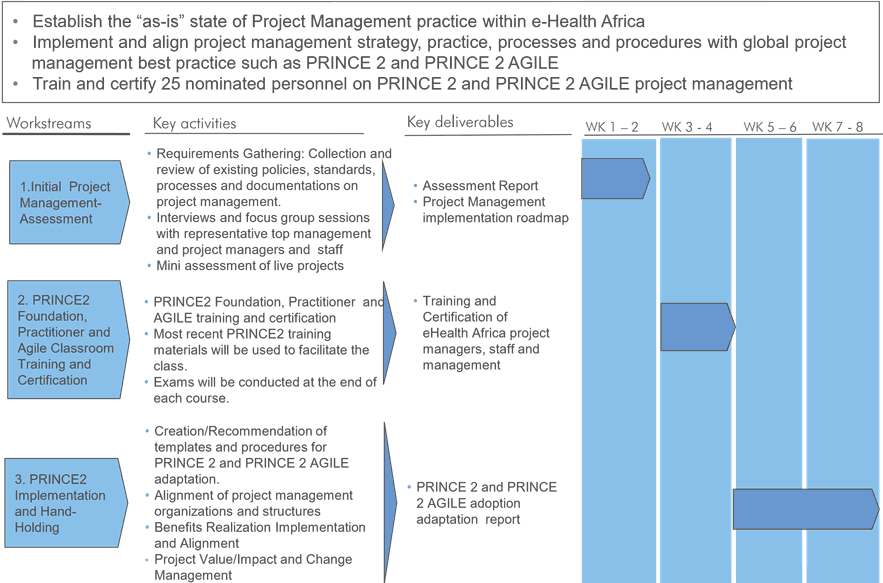
Figure 4.1 eHealth Africa PRINCE2 Agile implementation plan
The initial plan was to deliver training with certification exams in both PRINCE2 Foundation and Practitioner and then PRINCE2 Agile Practitioner for nominated personnel, which would then be followed-up with the adoption and tailoring of the PRINCE2 Agile method. However, on further assessment, the lead consultant recommended changing this approach, due to the significant number of people that would require training, as well as the logistics of their availability.
The change was to have two cohorts trained over consecutive 4-week tranches, with the hand-holding sessions to immediately follow the training. The two-week gap between the two tranches, allowed for an accumulation of lessons, a deeper evaluation of the plan and direction of the training and adoption programme, as well as the continued justification of the business case via the project board.
The change request was approved and consequently, the use of the two tranches with a two-week break allowed for the better execution and control of the entire training and adoption programme. It certainly provided improved evaluation of progress and the application of lessons learnt. Figure 4.2 shows excerpts of the implementation approach after the change was approved.
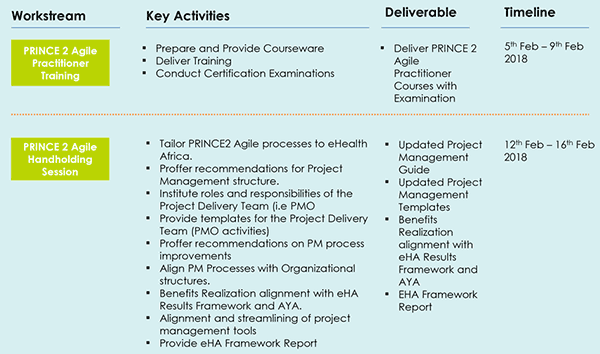
Figure 4.2 Excerpt - project implementation approach and timelines
Summary of the scope of the delivery plan
PEOPLE
- Build on the previously undertaken skills assessment and audit of existing processes.
- Training provided with certification examinations (2 rounds of training and certification).
- Identification of PRINCE2 Champions for the adoption phase and help with embedding new culture. These individuals were chosen using a combination of their ability to grasp the essentials of the method as demonstrated during class interaction and understanding of the practical application as discovered during the hand-holding sessions.
- Hand-holding sessions for project managers and other key project personnel to assist in the application of knowledge gained and adoption of key elements of the method. It was important to hold workshops for other project contributors, such as team leads, product leads and business analysts, to provide insight into the benefits of the best practice recommendations. This was particularly important for those who were not receiving formal training as part of the initial cohorts. Those already familiar with agile ways of working, were particularly pleased to note that the agile artefacts they had in place, need not be replaced by more formal documentation.
PROCESS
- Assessment of existing project management processes and tools for effectiveness and ease of integration.
- Held several workshops and sessions to start the journey towards the adoption of PRINCE2 Agile for the entire organization. Project managers assisted with the relevance/application of best practice processes.
- Establishment of a proprietary project management method based on PRINCE2 Agile best practice.
- Held workshops and sessions with senior management to help with better understanding of their roles within projects and the tools available for them, including PRINCE2 Agile project health checks.
- Formal Highlight Reporting was combined with informal feedback to the sponsor - the Deputy Country Director of Programmes. See dashboard in Figure 3 for reporting excerpts.
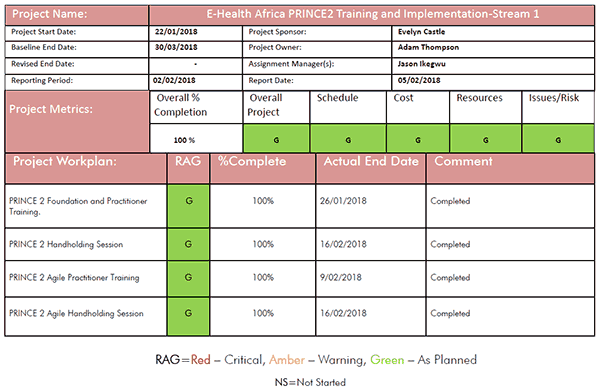
Figure 5.1 Project reporting excerpts – dashboard
TOOLS/SYSTEMS
- Assessment of risks of applying agile on current projects through interviews with project managers using the Agilometer.
- Encouraged the use of the Product Based Planning technique during the programme planning process, to ensure the adequate capture of scope and a focus on the quality of products.
GOVERNANCE
- Tailoring of documentation (management products) including reports and key documents such as the business case. For example, the format of risk registers, included the option of being displayed on a whiteboard, or on a screen in the ‘development room’ for ease of visual access. The need for agile behaviours of varied communication and transparency was encouraged and monitored.
- Recommendation was proposed to eHealth management to establish a Programme/Project Management Office (PMO). This was accepted and the Project Support Unit (PSU) was subsequently created after the training and adoption programme, to manage the implementation and continuous improvement of the tailored project management method and processes.
- Liaise and work with the existing Project Boards to ensure that the adoption of the new processes was applied to their projects.
- Project management governance framework tailored to align with the eHealth project environments. The governance guidelines require all projects to have a project board with the recommended roles filled, based using the best practice approach of ensuring that the business, user and supplier interests are represented appropriately. It was important to highlight the use of tailoring at the project board level, in order to ensure that the most appropriate stakeholders were in the roles of Executive, Senior User and Senior Supplier..
There were several impactful interventions and introduction of tools/techniques on the training and adoption programme. Perhaps the most significant was the use of the Agilometer (see Figure 2) to assess the risks associated with applying agile ways of working. Another example is the demonstration of use of the Cynefin framework (see Figure 3) in assessing the complexity of a project or a project’s final deliverable.
The Agilometer
With the Agilometer, the approach used during the hand-holding sessions is similar to one typically adopted when undertaking a Maturity Model assessment as stipulated in the P3M3 Maturity Assessment guidance.
The project managers were first allowed to perform a self-assessment on their current projects and provide values for each of the six sliders on the Agilometer. The project managers were then asked to justify the values they had assigned by contrasting their values with the guidelines in the PRINCE2 Agile manual for the sliders. In a vast majority of cases, it was clear that the slider values needed to go lower, based on the realities of the projects at that time. Ideas were then shared on how best to improve those areas going forward. For example, engaging with the external stakeholders earlier during the lifecycle of the project and providing them with some Agile coaching.
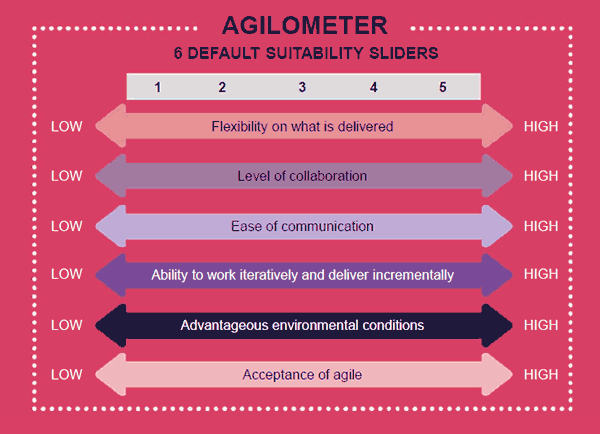
Figure 6.1 The Agilometer
Interestingly, after several project managers had been taken through the exercise, it was discovered that the last two sliders on the Agilometer were providing pretty much similar values due the lack of awareness of Agile on the part of the external stakeholders, including those in the Senior User role. It was therefore decided that the last two default labels would be tailored for some of the projects, so that a customized Agilometer with a new label on the sixth slider would be used to provide better insight into readiness of the project environment.
The CYNEFIN FRAMEWORK
With the Cynefin framework, it was easy to demonstrate the use of the technique due to the very nature of the space eHA operates. It was demonstrated that given the different eventualities possible in the public health space, the Cynefin framework can be used to help determine the level of complexity of a problem and therefore, the appropriate response. The possible scenarios range from routine vaccination programmes to the possibility of a sudden outbreak of a previously unknown disease with high fatality.
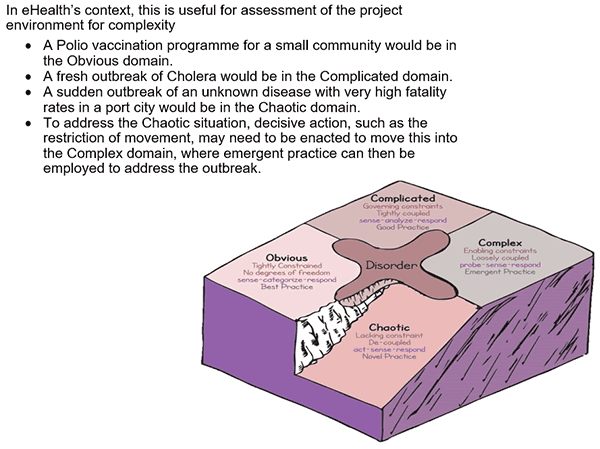
Figure 6.2 The domains of the Cynefin framework
Challenges and solutions
It is virtually impossible not to encounter challenges when introducing a cultural change through new ways of working. Here are the key solutions that mitigated and resolved the adoption of PRINCE2 Agile for eHealth.
| Challenge | Solutions |
|---|---|
Resistance to change | This was addressed by management providing strong buy-in and visibility for the training and adoption programme and steps by management to ensure that all key divisions in the organization participated. The programme sponsor was a member of senior management, namely the Deputy Country Director of Programmes. Nevertheless, eHealth Management did a good job of ensuring that staff were left in no doubt that the initiative was driven from the Chief Executive and that support was evident to all stakeholders. After the first week of training, the attendees witnessed the practical benefits of the method and they began advocating its benefits to their colleagues. Regular communication within the organization throughout the adoption process. This was done through visual charts and display of information on whiteboards as well as on-the-wall display screens from the management tools like JIRA. Frequent updates such as FAQs and newsletters helped improve the communication of changes and promoted acceptance. Expanded the adoption team to include team leads and the co-ordinators to advocate at different levels. Internally-led PRINCE2 training was provided with sponsored certifications as an incentive, recording an over 90% average pass rate for the PRINCE2 Foundation exam. Reward mechanism process was developed to acknowledge early adopters of the PRINCE2 process. Early adopters were awarded gifts at the organization’s events and recognized via the internal newsletters. |
| Initial understanding of timelines found to be unrealistic as adoption increased | It is not uncommon to have to adjust the timescales for adoption of best practice as this is a culture change being introduced to the organization. The adoption process was broken into two phases. The first phase to standardize processes and documentation and the second phase saw the set-up of the project management office to improve processes from lessons learned including the introduction of quarterly health checks for projects. |
| Many tools - Challenge of selecting the ones to be used | Interviews took place with the primary users to assess the effectiveness of the tools, in line with the organization’s strategy. A recommendation was then made on which tools should be retained as standard. Careful review during the adoption process saw some tools retained with more improved usage. For example, existing tools were expanded to manage daily logs and checkpoint reports, integrated within one system. |
| In addition to the traditional process being formalized, the formal integration of agile resulted in challenges with having too much documentation at the team delivery level. | Recommendation on the definition of which documents should be used for different projects. Based on complexity and project size, determine what level of documentation was required. Made the process more Agile by using tools to reduce how many different systems documentations had to be entered in. This improved efficiency and effectiveness. |
| Acceptance of the new methods across the entire organization | Tailored training and workshops for the executive management level to highlight the expectations of them, in helping to adopt the new ways of working. Similar tailored training and workshops were provided for entry-to-mid level staff. Adapted project manager performance assessment process to include results of the healthcheck. Currently being tailored to cut across all members of the project management team for all projects. |
Outcomes and benefits realized
The benefits of the project were evident as early as the training for the first cohort and initial hand-holding activities were completed. There have been a combination of tangible and intangible benefits over time and a good number of these will impact the organization well into the future.
- The tailoring of PRINCE2 Agile aided the adoption and embedding of the project management method.
- The development and adoption of a standardized tailored project management guide and project management governance framework has resulted in improved consistency in project delivery and governance. Figure 8.1 is a representation of the tailored guide for eHealth projects.
- The establishment of the PMO called the Project Support Unit (PSU).
- PSU-led quarterly health checks initiated and currently being practiced.
- Wider acceptance of PRINCE2 Agile throughout the organization.
- Far-reaching cost benefits and cost reduction have been seen with improved project initiation processes and the inclusion of a monthly budget and expense reviews during both project delivery phases.
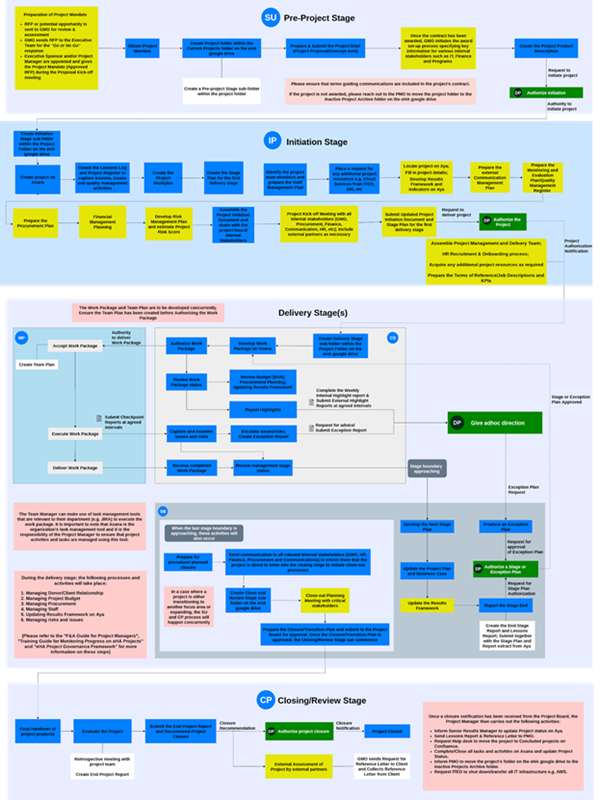
Figure 8.1 eHA tailored project management process
Ongoing improvements
To ensure that the PRINCE2 Agile method is maintained and incorporated as best practice, eHealth put in place key activities like coaching, reviews and assurance. This laid the foundation for further tailoring of the best practice guidance and better knowledge management.
- Implement continuous improvement and drive maturity through the conduct of quarterly project health checks and iterative application of lessons learned.
- Review of the organization’s project management guide and the governance framework as part of continuous improvement.
- Conduct training and coaching on PRINCE2, PRINCE2 Agile and MSP, currently embedding a tailored short course on the introduction to the PRINCE2 method as part of new project management and project support staff onboarding.
- Further tailoring and optimization of tools to see which documentations can be integrated within the existing tools.
- Review and adapt project management processes to align with organizations existing standard guidelines and policies across key functional and operational areas.
Summary
The adoption and tailoring of PRINCE2 Agile has been hugely beneficial for eHealth and is delivering value across the organization. Here are the key items that you may want to consider for your adoption programme.
- Ensure change initiatives are continually monitored and adapted, no matter how straightforward they may appear during the conception.
- The introduction of best practice clearly resulted in a consistency of approach on all of the organization’s projects. With the investment in training a sizeable percentage of the personnel and the monitoring of individual performance, a renewed sense of purpose was created across the organization.
- The use of the PRINCE2 Agile tools, such as the Agilometer, can be of great help to assess and minimize the risks of adoption in any environment.
- The adoption of best practice yields better oversight of projects and benefits realization, through the use of healthchecks.
- The rate and ease of acceptance can be improved by ensuring effective and consistent stakeholder engagement from the start, and identifying champions who will help to maintain the momentum of the overall vision.
- Certifying and upskilling people ensures better engagement and buy-in from stakeholders, as they will feel that they are valued contributors to the best practice journey.
- Visible buy-in from senior management will provide organization-wide engagement and will empower the project and programme managers, the project management offices, as well as other support staff.
The findings here clearly show that a carefully managed introduction of best practice can radically improve the mindset of an organization and drive a common goal to seek better project outcomes and organizational benefits. It can serve to re-energise the workforce and embolden and equip them for the challenges ahead.
About the authors
Alim Ozan has been leading strategic Programmes and Projects for over 25 years’ and is particularly passionate about delivering organizational value through changing behaviour, underpinned by processes and systems. He is a qualified PRINCE2 Agile Practitioner, which he combines with other best practices such as Scrum, Kanban, Change Management, Six Sigma, Managing Successful Programmes and ITIL.
Victor O. Fashoro Lead Consultant - a PRINCE2 Practitioner with over 15 years’ experience of project delivery and certification training, as well as consultancy on project management frameworks. A PRINCE2 Professional and PRINCE2 Agile Practitioner and Accredited Trainer, who has delivered training and provided consultancy in over 15 countries. A full member of the Association for Project Management (APM).
Iheanyichukwu O. Uzoma is a Program Manager at eHealth Africa and he led the first phase of the eHealth Africa’s PRINCE2 Agile Adoption Project. He has a master’s degree in Systems Engineering Management (UCL) and is a qualified PRINCE2 and PRINCE2 Agile Practitioner, with over 10 years of project management experience. He is interested in improving his knowledge and experience with implementing PRINCE2 while applying a systems approach to projects and programs. z Stephanie O. Okpere is a Project Manager at eHealth Africa where she manages Portfolio Management functions for eHealth Africa’s Project Support Unit. She led the second phase of the eHealth Africa’s PRINCE2 Adoption Project. She has a master’s degree in Public Health and is a qualified PRINCE2 and PRINCE2 Agile Practitioner, with over 6 years project management experience. She is interested in improving and making strategic impacts in project management implementation and in global public health.
Uche O. Ajene is the Senior Communications Manager at eHealth Africa. She provides professional guidance and strategic directions for all eHealth Africa’s communications. She leads the team that supported organization-wide communication of project management processes and directions. Her team provided communications management support for the PRINCE2 Agile Adoption project.
Acknowledgements
- eHA P2 Adoption team, Kano, Nigeria
- eHA management, Kano, Nigeria
- Jason Ikegwu Kayode Adeoye, Phillips Consulting Ltd, Lagos, Nigeria
Further reading
PRINCE2 Agile for PRINCE2 practitioners (2018). Available at: https://www.axelos.com/news/blogs/october-2018/prince2-agile-for-prince2-practitioners [Accessed 30th October 2020].
5 ways PRINCE2 Agile brings structure to product delivery (2020). Available at: https://www.axelos.com/news/blogs/september-2020/prince2-agile-brings-structure-to-product-delivery [Accessed 30th October 2020].
PRINCE2 Agile – reducing project delivery cycles (2019). Available at: https://www.axelos.com/news/blogs/october-2019/prince2-agile-reducing-project-delivery-cycles [Accessed 30th October 2020].